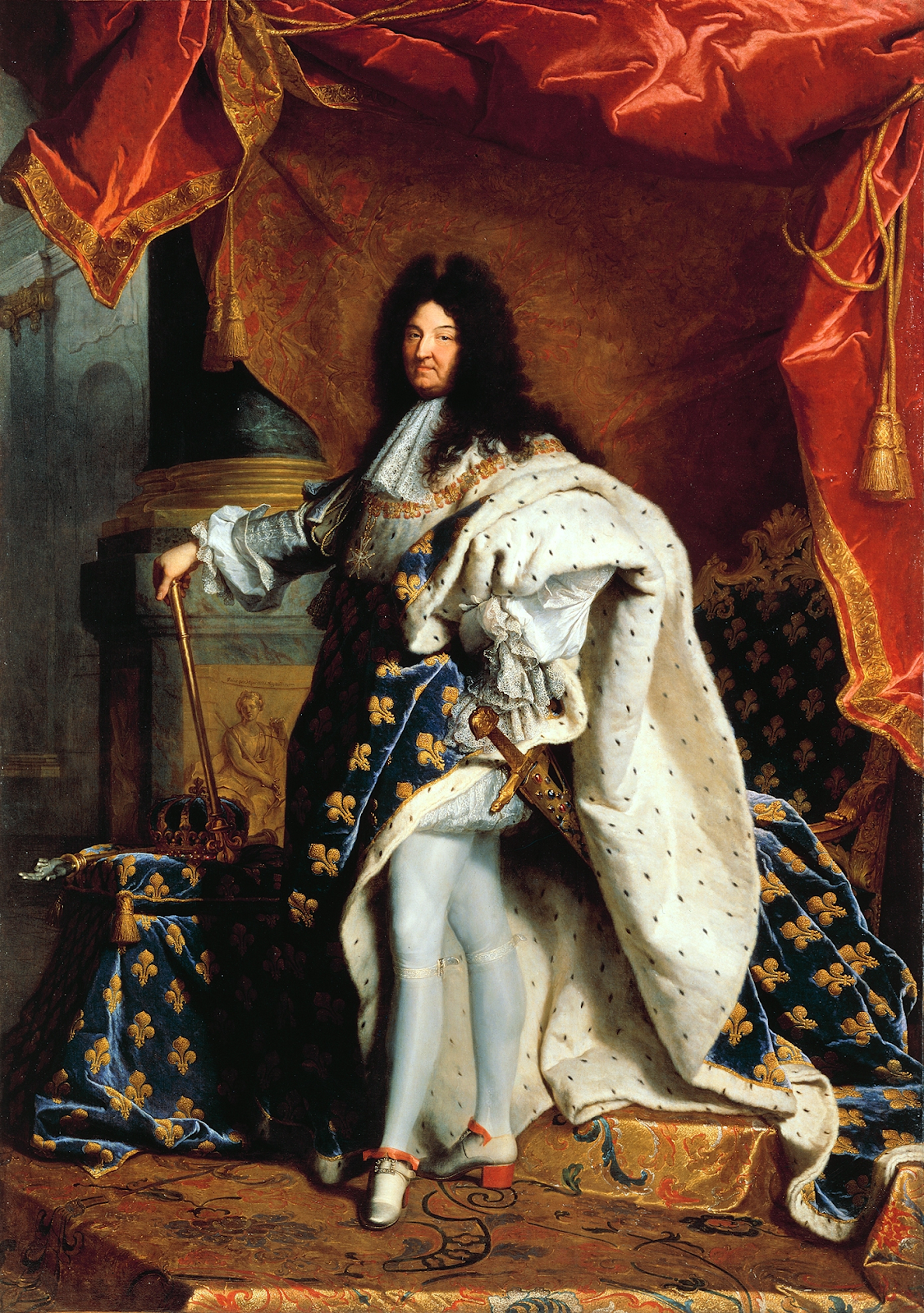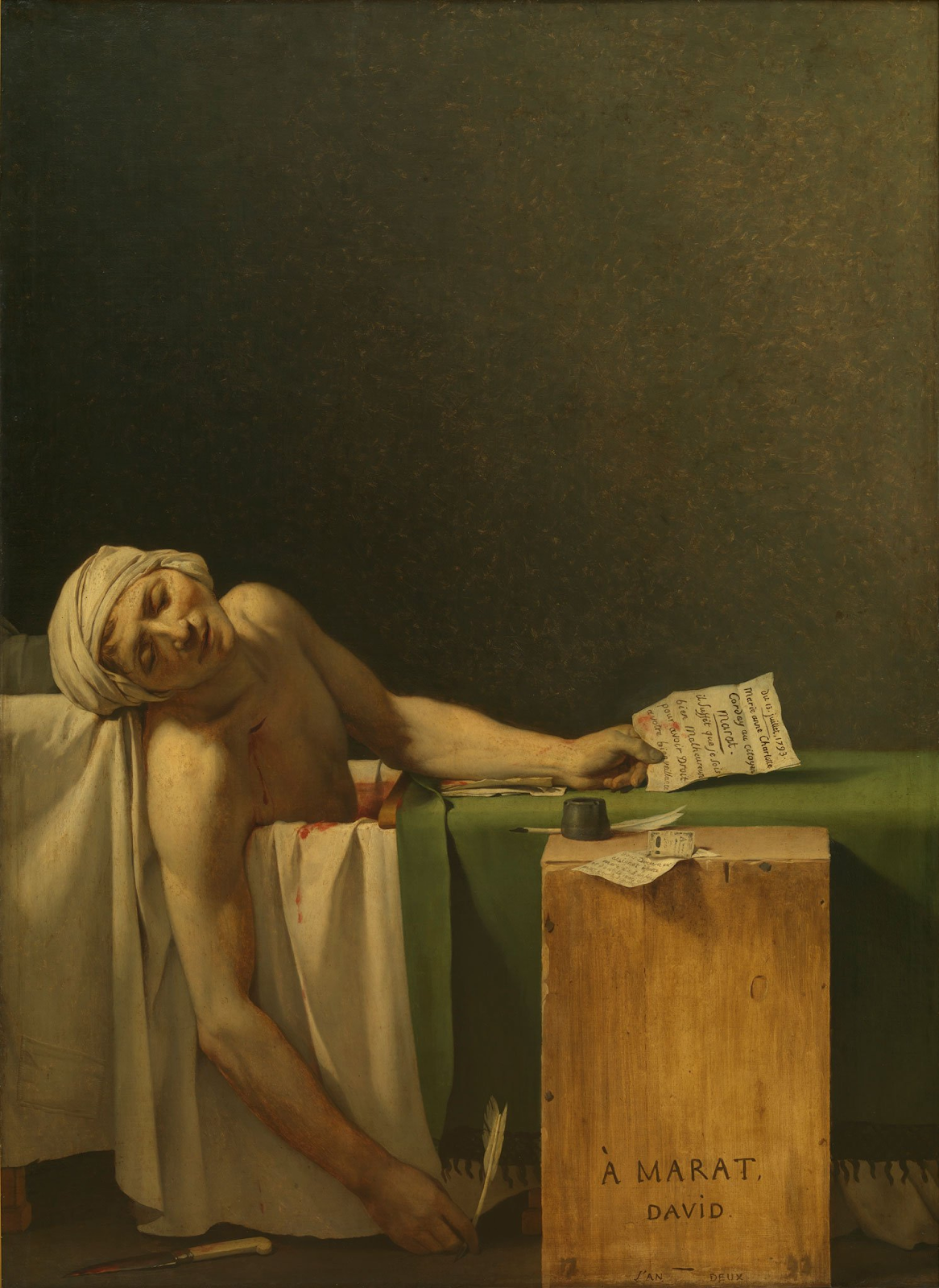How to Write a General Description Art History Paper
The following is a student newspaper from the course ART 188: History of Western Fine art (Renaissance to Modernistic). Miami kinesthesia from Fine art History have inserted comments to betoken and explain disciplinary writing conventions in Art History.
This sample contains 8 comments. These comments appear within the text of the article and are noted with assuming text, brackets [ ], and the word "annotate" before the text they refer to.You lot can as well view these annotations and the original paper in aGoogle Dr. format.
Sample Annotated Student Essay for ART 188
The Essay Prompt
Compare Hyacinthe Rigaud's painting Louis XIV (1701) (on the left) to Jacques-Louis David's Decease of Marat (1793) (on the right). Both of these artworks were made for explicitly political purposes, though they clearly draw very different types of figures and employ very different styles. Compare these two artworks in terms of how they convey their particular political message to the viewer. What strategies does each artist employ and why? What are they trying to communicate to the viewer about the state?


The Annotated Student Essay
A Martyr of Royal Proportions
[Comment ane: Introduction sets the context without making claims that are too broad or general. Besides sets the tone for a focus on grade disharmonize.] For the majority of the eighteenth-century, French farmers stayed starving and cold while an elite class of dignity consumed them. For years, the upper echelon of French society relied on the claret and sweat of the layman to provide them with aplenty nourishment. Just after the spring of 1791, the fields would be nourished past the blood of laymen and aristocrat alike, and the onetime ways would be no more. A revolution had begun, and revolutionary figures similar Jean Paul Marat would be painted in stark contrast to the grandiose portraiture of King Louis the Fourteenth nearly a century prior. [Annotate two: Clear thesis signals what the statement will be and why comparing these two paintings is worthwhile.]Indeed, the transition in composition from the early eighteenth century spoke to more than simple brushstrokes. It represented the political enlightenment of the French people attempting to secure for themselves unalienable liberties they had been denied so long. Marat, therefore, was not simply a brutalized revolutionary lying lifeless in his bathtub; The Decease of Marat depicts the efforts of the enlightenment revolution ferociously contesting with the onetime paradigm of French government.
[Comment 3: Clear topic sentences signal what each paragraph will clarify.] When comparing two pieces it is important to recognize their respective contexts get-go. The Louis Xiv portrait is painted by Hyacinthe Rigaud during the early Enlightenment period of France in 1701. This painting has Rex Louis Xiv surrounded past opulence in a very stately posture. Louis states, "I am the state," reinforcing his office every bit monarch of France for anyone viewing his kingly grandeur. The Death of Marat , however, imparts a very dissimilar sentiment. Painted by French revolutionary artist Jacques-Louis David in 1793, The Death of Marat displays the infamous revolutionary author is lifeless in a tub. At the height of the French revolution, he is soaking in a mixture of medicinal sulfur used to treat a rare skin condition he contracted in the sewers of French republic. Indeed, this disease that Marat contracted in the sewers placed him in the tub he would be murdered in. In this way, the poverty that drove him into the sewers also drove him to his demise; the French elite could expunge the poor from the streets, but they could never extricate the ideas Marat imbued. The slice evoked compassion and provided justification to the many rebellious Parisians for whom he spoke. Furthermore, the painting immortalized Marat equally a martyr and freedom fighter in the optics of his fellow revolutionaries. The Louis XIV portrait flaunts power and status while The Expiry of Marat condemns monarchical dominion in France.
After examining context, it is crucial to integrate the content of the works to go at their underlying significant. Examining the content of the Louis Xiv portrait gives the viewer an idea of the intentions and priorities of the French rex. Information technology is specially apparent that the king has a lot of coin. [Comment iv: Descriptive prose points to specific aspects in the piece of work of art.] His encrusted sword and outrageously fanciful robe serve to eternalize his status and wealth. It would near seem that in a secondary attempt to avoid existence straight arrogant, these items are also imbued with a national relevance. The ludicrous robe displays the three-pronged lily representing the French monarchy, and his encrusted sword represents French war machine might. It is his shoes that cannot be accounted for. The male monarch, one-time and sickly as he actually was, adorns some fashionable footwear to juxtapose his position as self-proclaimed "Sun King" with some suave gimmicky sneakers and a cheeky flash of the thigh. As powerful and sophisticated equally he may have been, this portraiture shows [Comment 5: Returns the analysis of symbols inside the painting to the context of class conflict signaled in the introduction.] a clear separation from reality; the wealth and power of "France" depicted in Louis' portrait was not representative of the people who actually lived at that place. It was only relatable to the fancifully rich. Comparatively, the Marat portrait makes Male monarch Louis look like a bad try at sense of humour. The Expiry of Marat was something extremely real and very relatable. It illustrated a homo who suffered dearly at the paw of the monarchy and was ultimately killed past those who supported its rule. The rich and famous could never relate to The Expiry of Marat in the same fashion Parisians did; Marat would accept been more than honorable in the optics of the public than whatsoever would-be rex. Marat is shown in his tub, papers under arm and his quill in hand. Information technology would appear that he was working on some enlightenment literature when he received a letter which tricked him into granting his killer access to him. Like to the Louis 14 portrait, Marat'due south torso is sculpted with the precision and attention expected of the neoclassical age. The sickly and bleeding body of Marat elicits a specific emotional reaction of resentment and remorse. That the Marat painting gained the popularity that it did supports the idea that people began to chronicle more with enlightenment concepts and less of the thought of a male monarch.
The proficient hand of each artist has a unique place in the message of each painting. The split pieces are painted with unique and very different forms. Looking at the Louis XIV painting one notices that it is very full. This is causeless to exist an intentional detail, as a king would surely take many possessions. Small shadows hide in the creases of cloth behind him. The just true shadow that rivals that of the male monarch is in the very back of the painting well-nigh out of sight. Information technology would not be a stretch to say that the painting is full of cloth, and every textile is radiant with color. [Comment 6: Attention to formal detail reasserts and supports the chief statement about course and the king'due south presentation within the painting.] Lite comes from the correct-side illuminating Louis the Xiv making him look larger with his robe on. The piece is extremely skilled just has some element of blurring when looked at closely. The overall atmosphere is one of style, colour, and power regarding the king. The Marat slice does not share much with the Louis portrait; it is of a bath tub, a man, and a desk. The details of Marat are more than vivid and retain their integrity upon close inspection. Marat himself is so realistic, he truly looks lifeless. [Comment seven: Formal analysis hither connects to prior form content, and points to the fine art historical references within the painting.]His posture is very reminiscent of pieta, reinforcing his martyr status in a Christ-like fashion. Despite the detail and realism of Marat, [Comment 8: Looks not only to what is in the painting, merely how absences are treated, considering the unabridged limerick.]the stark ambiguity of the upper half of the painting is both anarchistic and genius. With a black top one-half, in that location is nothing but Marat himself to focus on, the only thing one can really meet and feel is Marat. Every bit a outcome, the piece evokes keeps the viewers attention and feeling on the death of the man. One might inquire who would do such a affair. Then reply inevitably reached is the monarchy.
The differences in context, content, and form of The Death of Marat and Louis 14 vary widely. These aspects are essential to the message and reception of the works. Their comparison brings out everything that is right, or wrong, with the letters they impart. In the example of David'southward painting, it simply elicits the exact emotions people needed to feel; the emotions they needed reassurance of if they were to carry out their crusade. The power of The Expiry of Marat inspired people to carry on fighting for the French Revolution. The influence of art certainly stretches beyond the construct of the heed, art is role and packet of society, and should be regarded so dearly.
brandtlihaboulady.blogspot.com
Source: https://miamioh.edu/hcwe/disciplinary-writing/art-history/annotated-paper-art-188/index.html
0 Response to "How to Write a General Description Art History Paper"
Post a Comment